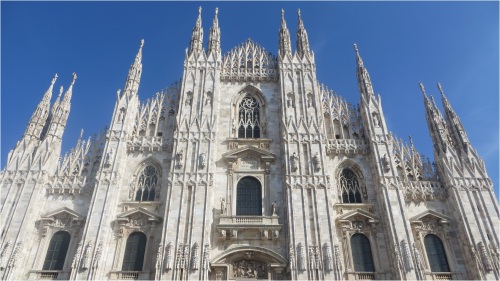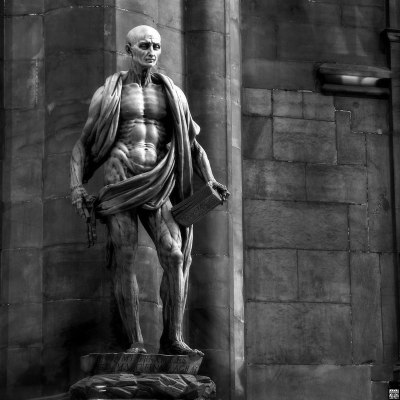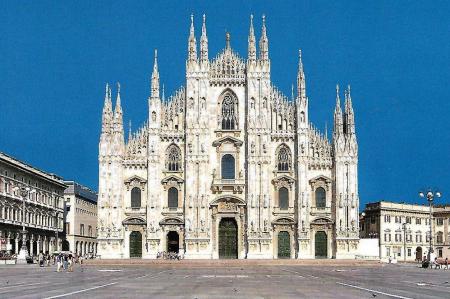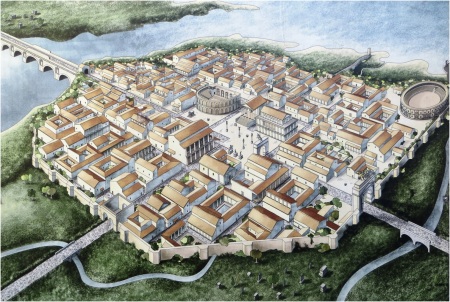
“What a wonder it is! So grand, so solemn, so vast! And yet so delicate, so airy, so graceful! A very world of solid weight, and yet it seems …a delusion of frostwork that might vanish with a breath!…”, Mark Twain – ‘The Innocents Abroad’
We left Rimini early in the morning. We booked the fast train and were especially careful to make sure that we caught the right one this time. Kim fell asleep. The journey took two hours and we arrived in Milan around about midday and walked to the IBIS Hotel.
We only had an afternoon in Milan so we had to make a choice about what we would go and see. Should it be Leonardo Da Vinci’s Last Supper at the Convent of Santa Maria delle Grazie or alternatively visit the largest Cathedral in Italy.

We decided upon the Cathedral and this was our reasoning.
The Last Supper by Da Vinci isn’t the original.
The work started around 1495 but due to the methods used, a variety of environmental factors and some intentional and accidental damage, nothing of the original remains.
Because the painting was on a thin exterior wall it was affected badly by humidity and the paint failed to properly adhere and after it was completed it quickly began to deteriorate. By 1517 the paint was flaking, by 1532 it had lost most of its colour and detail. In 1652, a doorway was cut through the painting, and later bricked back up. In 1768, a curtain was hung over the painting for the purpose of protection but instead trapped moisture on the surface and whenever the curtain was pulled back it scratched the flaking paint.
A first restoration was attempted in 1726 and a second in 1770 both were criticised for not faithfully reproducing the original. In 1796 French troops threw stones at the painting and climbed ladders to scratch out the Apostles’ eyes. The refectory was then later used as a prison. A repair project was attempted in 1820 but this only succeeding in damaging the work when a whole section fell off the wall.
Who remembers this famous bit of art restoration?

During World War II the refectory was struck by Allied bombing and the painting was damaged by splinters and vibration. Between 1978 and 1999 the most recent major restoration project undertook to stabilise the painting and reverse the damage caused by dirt and pollution.
So this is my point, this is why I mention this here – it is possible to go to see the painting, a painting, but it isn’t by Leonardo Da Vinci that’s for sure so if it isn’t an original what is the point!
There are lots of other versions of the Last Supper – this is one of my favourites…

We were also influenced in our decision making by the fact that it costs €40 to visit the Basilica to see the painting but only €10 to visit the Cathedral and climb to the top of the roof. We chose the Cathedral.

I have made no secret of the fact that I didn’t especially like Milan but I have to say that the Marble Gothic Cathedral is perhaps one of the most sublime and finest that I have ever seen in Italy. In design, more French than Italian perhaps. The location is magnificent with a wide open Piazza to the front and it rises dramatically towards the sky with spires like needles piecing the blue, each one decorated with a Saint or Apostle at the very top.
It is claimed there are more statues on this cathedral than any other building in the world; there are three thousand, four hundred statues, one hundred and thirty-five gargoyles and seven hundred figures. There are two hundred and forty steps to the top but that did not concern us, we had climbed nearly five hundred in Bologna so we ignored the extra charge for the lift and began the ascent.

Now this was really something really worth doing and well worth the admission charge. My first impression of the roof was that it resembles a petrified forest, There was a lot of restoration work at the top but this didn’t interfere with the stunning views and the rooftop panorama of the city. We stayed up on the top for quite some time and after two circuits made our way down the steps and into the Cathedral which was equally impressive.
I will tell you two stories…
Above the apse there is a spot marked with a red light bulb. This marks the spot where one of the nails of Jesus’ crucifixion was allegedly placed. Once a year in September the archbishop of Milan ascends to the apex in a wooden basket decorated with angels to retrieve the nail. The nail is displayed on the altar for three days and then put back again. You do have to wonder why?
Inside the Cathedral is a statue of the Apostle Saint Bartholomew who met an especially grisly end when he was skinned alive. Condemned to death he was flayed and the skin of his body cut into strips,then pulled off leaving his body open and bleeding for a long time, after that he was beheaded and then crucified just to make sure. I am prepared to be challenged on this point but I don’t believe that it would be possible to be skinned alive, I imagine you’d die of shock quite quickly. The pain must have unimaginable, I know I call for a sticking plaster for just the tiniest of little skin-nicks!
We left the Cathedral and took the dreary walk back to the hotel. I still hadn’t warmed to Milan but the Cathedral helped redeem it a little.
Considering it is such a centre of high fashion, Milan is remarkably devoid of architectural beauty. Milan is all about making money, it is in the blood and in the history” – Michael Palin, ‘Hemingway Adventures’.










































































